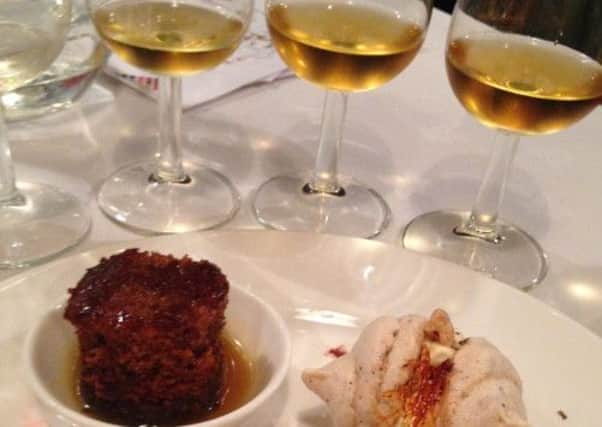Wine: The gold standard


There wasn’t a seat left at The Treasurer’s House in York when Master of Wine David Bird matched Hungarian Tokaji from The Royal Tokaji Company wines to not just a range of desserts, but to a meaty main course too. This tasting was just one of the events at last month’s York Food and Drink Festival which saw tens of thousands of people throng into the centre of York to sample local foods, watch chefs’ demonstrations and taste wine.
Tokaji (pronounced Tock-aye) comes from north eastern region of Hungary, on the borders of the Ukraine and Slovakia.
Advertisement
Hide AdAdvertisement
Hide AdVines have been cultivated here since Roman times but the first sweet wines of Tokaji supposedly date back to 1650 when local people fled ahead of an advancing Turkish army. Grapes were abandoned on the vines and when the populace returned they managed to save the harvest by making a sweet wine from these over-ripe and mouldy grapes.
The result was astonishingly good and from then on, this region developed its sweet wines to the point where they were in demand by every crowned head of Europe. The Russian Czar kept a garrison of soldiers here just to protect the “wine with the price and colour of gold”.
These days we are used to reports of the health-giving properties of wine, but the sweet wines of Tokaji carry more legends than most. With stories of Emperors climbing off their death-beds after just a few sips, maybe this is a wine which should be on prescription. Top quality Essencia Tokaji is so sweet it struggles to reach 3% alcohol and it is sold with a crystal spoon, for administering, rather than drinking.
But although the wines of Tokaji are generally thought of as sweet, there is a drier side to this region. Weather conditions are not always right to make sweet wines and in volume terms dry wines exceed sweet many times over.
Advertisement
Hide AdAdvertisement
Hide AdMade from the Furmint grape, dry Tokaji is a style of white wine all on its own. The grape has honey notes and flavours of fennel and herbs which gives it a savoury character wrapped up in clear-as-a-bell acidity that accompanies food perfectly. At the tasting in York, Tokaji Furmint 2011 (Majestic £9.99 for 50cl, down to £8.99 on multibuy) started off the proceedings and it shone with lively herbal notes, honeyed apricot flavours and a zing of freshness which made it a perfect and different aperitif.
To accompany a flavourful beef goulash, spiked with paprika, Royal Tokaji Furmint Dülöválogatás 2010 (around £20 difficult to find at present), made from a blend of grapes from two top quality vineyards, gathered more intensity, with definite notes of thyme, fennel and honey, backed by mineral complexity and with a long, serious finish. This wine has the structure of a fine white burgundy with focus and linear freshness.
Then came the desserts, each one created to balance the weight of the sweeter wines, but first, David Bird, who acts as a consultant to The Royal Tokaji Company, explained the process of making these extraordinary wines.
As well as Furmint grapes, the region is also planted with Harslevelu and Muscat Blanc à Petits Grains which each add their own character to the final wine. To make sweet wines, the grapes are left on the vines for varying amounts of time which concentrates the flavours, leaving the acidity intact.
Advertisement
Hide AdAdvertisement
Hide AdLate Harvest 2011 (Majestic £9.99 for 50cl) is just that. Made from ripe grapes left on the vines for a short time to concentrate, it has a nose reminiscent of exotic fruits, backed by clear citrus acidity. It is gently sweet but in a very balanced way and it chimed perfectly with lemon tart. To make sweeter wines, the grapes are left even longer on the vines, so that in the cool humidity of autumn mists, a mould develops on the berries. This is botrytis cinerea which covers the berries in a light grey dust and sucks the grapes almost dry, leaving them shrivelled but packed with sweetness and concentrated acidity. These grapes, known as Azsú, are harvested separately and, once the normal grape fermentation is finished, they are added back into the wine as a thick sticky paste.
The whole business of grading Tokaji starts at this point and the historic measurements of harvesting hods (puttonyos) and barrels (gönci) are used to describe sweetness.
Three Puttonyos is moderately sweet but the real gems start at four Puttonyos with five and six Puttonyos.
To go with a creamy hazelnut meringue, Royal Tokaji Blue Label 5 Puttonyos 2008 (Waitrose, £12.29 for 25cl) matched the sweetness and nutty flavours with apricot, quince and orange peel notes and cleansing freshness. Moving up to 6 Puttonyos Gold Label 2007 (around £28 for 50cl, usually available on restaurant wine lists) there were fabulous notes of butterscotch, marmalade and quince.
Advertisement
Hide AdAdvertisement
Hide AdThis is a sweet wine, but it was able to accompany a delicious sticky toffee pudding and still leave the palate fresh and clean. To round off the tasting Royal Tokaji single vineyard Szt. Tamás 6 Puttonyos 2007 (Berry Bros in London around £60 a half litre) is astonishing, deep with concentration and honeyed notes but still able to wrap itself around a rich chocolate marquise with fine, vibrant freshness.
As a region Tokaji has worked hard to establish itself after the long years of communism when quantity dominated quality.
Now companies such as Royal Tokaji, backed by investors such as wine writer Hugh Johnson are giving a taste of what these legendary wines really taste like.
Even if you think you don’t like sweet wines, try one at least. The combination of flavours is sublime.